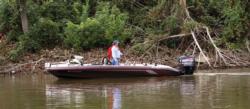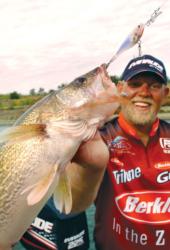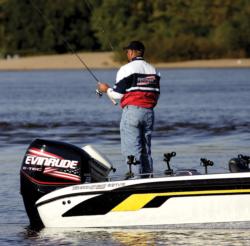The lowdown on rivers
Tips for catching walleyes in low water

Rivers can be maddening, constantly changing the way they do.
In natural lakes and even reservoirs, walleye movements are far more predictable based on water temperature and time of year. But in rivers, walleyes and saugers react to even the slightest change in water level. Finding fish in moving water is often a here-today, gone-tomorrow affair.
Much is written about how both species respond to high water and what anglers must do to cope. Charge the dam. Move toward the banks. Look for cleaner water.
But low water? Not so much. Maybe that’s because low-water conditions are not as dramatic as high water.
The reality is slower-moving, even sluggish, rivers with low or falling water levels are the norm most of the year. This is most obvious during summer. But, consider the scene early in the season before spring rains arrive or during fall and winter when precipitation can be spotty at best. Long-term droughts like the ones that have recently affected portions of the lower Midwest and North Woods add to the challenge.
Moving water helps anglers by concentrating fish behind current breaks where they wait in relative ease to ambush prey. Eddies created by both natural and man-made obstructions are sure to hold fish. But, what do we do when current eases and both predator and forage fish are free to migrate up or down the river system at will?
Time on the water has taught professional anglers like Larry Smith of Berlin, Wis.; Richard Nascak of Winona, Minn.; and John Balla of Bartlett, Ill., that low water means slow current – not zero current. Yes, fish scatter. But, because moving water helps walleyes and saugers in their hunt for food, they still seek out locations where water flows faster, even if it’s only slightly faster than the river as a whole. No matter how subtle, current breaks in sections of the waterway with relatively faster water will hold fish.
True, lower water might make productive spots shrink in size, and anglers must be far more focused when it comes to pinpointing places where current remains in play. But, fish will still be there, and fishermen who are able to target those areas best will catch them. Tactics depend on just how large those spots turn out to be.
Larry Smith, the Professional Walleye Trail Rookie of the Year in 2001, who joined the Wal-Mart FLW Walleye Tour in 2006, knows low water concentrates fish in another way. As water continues to drop, shallow features and structure eventually become too shallow for fish to use. As a result, they have  fewer places they can be.
fewer places they can be.
Richard Nascak, who won the 2006 FLW Walleye Tour Championship on Lake Oahe, but has formed his foundation on the Mississippi, honestly prefers fishing the big river during low-water times. Fish can’t disappear into the Mississippi’s vast backwaters, which means there is less water to search.
Low-water locations
The key words that help take the insanity away from finding fish in low water are narrow, deep and outside.
The Illinois River may be one of the best classrooms to learn what fish do in both low and high water. John Balla has had several solid finishes on the Illinois during FLW Walleye Tour and Masters Walleye Circuit events because he’s fished the waterway during both floods and droughts. He said, due to human activity, it’s a river prone to times of feast or famine where current is concerned.
The Illinois River was channelized to permit barge traffic, and feeder creeks were straightened to make water drain from farm fields faster. The result is a river where water levels can climb many feet overnight just after a rain. River engineers must be adept to release water upstream slowly enough to permit shipping while avoiding flooding crops downstream.
In contrast, water is held in pools to maintain enough depth in the channel to allow barges to navigate during times of little rain. As a result, the Illinois River is sluggish for much of the year.
“In summer, we always talk low current. But inherently, fall and winter are low-water periods, too,” Balla said. “In drought years, precipitation can be below average – even in spring.”
Slow water allows forage fish to scatter. As the food goes, so goes the system’s dominant, current-loving saugers. Balla said narrow sections of the river are key when that happens because water squeezing through tight spots flows faster. Check your map for neck-down areas.
Smith has faced similar conditions on the Fox and Wolf rivers due to season changes and a recent drought in Wisconsin. Fish moving upstream from the Winnebago chain to spawn have been unable to get into the marshes where they normally lay eggs. Anglers have been forced to target other areas toward the headwaters because the farther they travel upstream, the narrower the river becomes and the more current – and fish – they find.
That also holds true when the pack moves back downstream to the main lakes. Resident fish that remain in the river will continue to seek out the narrower portions of the river where current is relatively faster.
Richard Nascak also pointed out current, no matter how little or how much, moves faster on outside  bends where water acts like a row of soldiers marching around a corner in a parade. The outside soldier steps fastest while the inside one barely moves.
bends where water acts like a row of soldiers marching around a corner in a parade. The outside soldier steps fastest while the inside one barely moves.
Once faster-water areas are located, the search can be narrowed further by focusing on the same kinds of features that hold fish during normal flow.
Check out holes cut by the current over the years and by barge propellers revving up to navigate through the turn. Active walleyes and saugers will hold on the upstream side of the holes, especially ones with harder bottoms made of clay or sand.
Smith targets holes with wood – whether it’s a blowdown, drifted brush or a stump field – that can range from 3 to 12 feet deep. As the water drops, fish have fewer options. Bridge pilings in those areas will often have holes on the upstream side.
Sand dunes located on the main channel are another critical feature. On the Mississippi, Nascak looks for washboard bottoms on the sonar screen in water 14 to 22 feet deep. Dunes may change shape from current action over time, but they’ll remain in the same areas and hold fish year after year.
Man-made river structures where rivers narrow are also critical. That means wing dams on the Mississippi River. But not just any wing dam will do. Nascak said deeper ones that top out at 14 feet or so and are located on river bends are best. The first one in a series will catch most of the current, so try it first. Motor to the front of the dam; if there isn’t enough current to try to push you over the top, move on. If you fish the first dam in the series without success, don’t waste time trying the others. Run and gun until the right conditions – and the fish – are found.
Don’t overlook sandy areas between the dams. You can often single out the best ones by making a trip to the river at night. Shine a spotlight, and you’ll often see hundreds of glowing eyes staring back at you.
Nascak also cautioned not to overlook day markers that generally are near the channel and signal a wing dam. Though he rarely fishes them in normal or high water, the rocks around day markers might be exactly where fish are set up in low water.
Factory discharges can also attract and hold fish. The cuts leading to backwaters where forage fish spawn will also be good.
If fish are scattered – and they will be – Balla targets the main river channel on the bends. Start deep and move shallower until you find the right depth zone.
Here’s something else to consider. There are times the main river can be raging and ugly, flooded beyond fishable. But, the high water in the main river just might permit you to reach tight low-water spots in feeder creeks that walleyes and saugers will find to escape the torrent. That’s exactly what Ted Takasaki did to win the PWT Championship on the Missouri River system in 1998. Walleyes were in a hole with wood.
Location dictates tactics
Obviously, tighter structures that hold fish demand tactics that require pinpoint accuracy. Larger areas are ripe for effective trolling techniques.
 Smaller areas, like small neck downs and smaller holes, can be targeted by jigging or casting crankbaits or jigs or even three-way rigs from an anchored position.
Smaller areas, like small neck downs and smaller holes, can be targeted by jigging or casting crankbaits or jigs or even three-way rigs from an anchored position.
Sometimes pounding the bottom with big jigs is a great idea in high water, but this is not so in low water, which tends to be synonymous with clear water. Subtle in both size and color is often better. Low current permits lighter jigs; 1/4 ounce and 1/8 ounce will do. Stick with blacks, blues and purples, especially on sunny days. Chartreuse, pink and even orange can be the tickets on cloudy days. Choose a Fuzz-E-Grub jig or pinch off the tail of your favorite soft-plastic lure. Use scent. We know what you’ve heard about jigs and minnows in cold water. But, Balla, Smith and Nascak switch to half of a crawler earlier than most, at any temperature above 45 degrees.
Sometimes, trolling with three-way rigs in places where forward movement of boats is allowed can put bait in front of the most fish in the least time. It’s Balla’s favorite method when fish are scattered. He uses a 1-ounce Fuzz-E-Grub on a 6- to 12-inch dropper. He uses a 3-foot trailer on a minnow with a single red bead and hook or a 5-foot trailer for floating crankbaits like No. 7 and No. 9 Rapala Floaters. Move forward up and down the channel breaks or through the holes at various depths until fish are found.
Smith targets the holes two ways. Fish are spooked easily in shallow, clear water so he anchors above the hole and tosses snag-free jigs like the Lindy No-Snagg Timb’r Rock right to the edges of the wood, almost like a bass fisherman would do. Or, he bounces three-way rigs and live bait on a short leader to the upstream edge of the holes. Either way, the key is to use enough weight, usually 1/2 ounce, so the jig or three-way rig can be bounced on the bottom without pulling the bait forward. Be sure the weight drops back into place every time, then pump, pump, pump.
“You know the fish are there, but sometimes they have to see it 10, 20 or 40 times before you’ll get that bite,” Smith said.
Stay in that area about 10 minutes. If you get a bite, that’s great; stay awhile longer. If not, pull up the anchor and move on.
Smith also likes to troll three-way rigs, where permitted. On the business end, he’ll use streamer flies manufactured up to 3 inches long and made with deer hair and a couple of strands of tinsel. Like Balla, he moves up and down the channel breaks using a trolling motor. Here’s a tip: Smith uses 14-pound stiff line so the hook doesn’t sway as much.
Three-way rigs are also great for fishing wing dams. Nascak anchors upstream from the outside edge and casts three-ways with willow cats or night crawlers to the eddy created by current churning at the base. As an alternative, he’ll point the boat upstream and use his trolling motor to hover above the dam as he lets out line to permit the bait to reach the base. Turning the motor slightly right or left swings the baits across the face.
Nascak also likes anchoring upstream within casting distance of the dam and targeting the top and the face with No. 5 and No. 7 Shad Raps. His favorite color is white.
Smith also likes casting crankbaits at gravel bars early in the morning and later before sunset before walleyes move off.
Nascak and Balla rely on lead core for scattered fish on larger spots like channel edges on river bends. Nascak will also run lead core right along the edges of a series of wing dams.
Balla likes 27-pound lead core – the stronger sheath lets him pull lures free of woody debris. A small barrel swivel prevents line twist. You can finish the setup with a 6-foot leader of 20-pound braided line like FireLine Crystal to a crankbait clip and Shad Rap. Troll about 2 mph. Let one angler watch the depth to keep the boat at a precise depth and speed to avoid baits moving out of the strike zone or banging the bottom and picking up debris.
There’s no need to go crazy when the water is low. Just become a deep thinker and go with the flow.